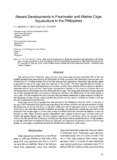Recent developments in freshwater and marine cage aquaculture in the Philippines
- Global styles
- MLA
- Vancouver
- Elsevier - Harvard
- APA
- Help
Share
Abstract
Fish production from freshwater cages and pens, and marine cages and pens constitute 19% of the total foodfish produced from aquaculture in the Philippines. In 1998, production from freshwater cages and pens contributed about P 2.5 billion or about 10% of the total revenues from aquaculture. Freshwater cage and pen culture is practiced in most of the major lakes and reservoirs in the country. The most important species cultured in freshwater cages are tilapia and bighead carp (Aristichthys nobilis) while milkfish (Chanos chanos) is farmed in freshwater pens at Laguna de Bay. Small water impoundments intended for the irrigation of upland farms are also being used to culture tilapia and other freshwater fish in cages. The unregulated expansion of cages and pens, use of high stocking densities, and excessive feeding has resulted in the deterioration of the water quality in many areas. This has prompted the more informed local government authorities to adopt measures limiting further expansion of cage and pen culture activities beyond the carrying capacity of freshwater bodies to prevent periodic occurrences of mass fish kills.
While cage mariculture of groupers has been practiced in the Philippines since the 1980 s, it was only in the early 1990 s that much of the growth and expansion of the industry occurred with the popularization of milkfish mariculture. In the last five years, no less than 1,000 cages with an aggregate capacity in excess of 10,000 metric tons a year have been invested in milkfish sea farming. The species now acounts for about 90% of the production from marine cages. In recent years, a drop in milkfish prices has motivated the industry to focus its attention on other fishes, primarily grouper (Epinephelus spp.), snapper (Lutjanus spp.), sea bass (Lates calcarifer) and siganid (Siganus spp.). Currently, imported species such as red tilapia, yellow-wax pompano (Trachinotus blochii) and red drum (Sciaenops ocellatus) are also being tested by the private sector. A high production cost due to low feed conversion efficiency and high seed cost is presently the greatest concern of marine cage farmers. In some areas, unregulated expansion has already led to problems in water quality.
Suggested Citation
Marte, C. L., Cruz, P., & Flores, E. E. C. (2000). Recent developments in freshwater and marine cage aquaculture in the Philippines. In I. C. Liao & C. K. Lin (Eds.), Cage Aquaculture in Asia: Proceedings of the First International Symposium on Cage Aquaculture in Asia (pp. 83–96). Manila, Philippines: Asian Fisheries Society; Bangkok, Thailand: World Aquaculture Society - Southeast Asian Chapter.
Type
Conference paperCollections
- Conference Proceedings [298]


